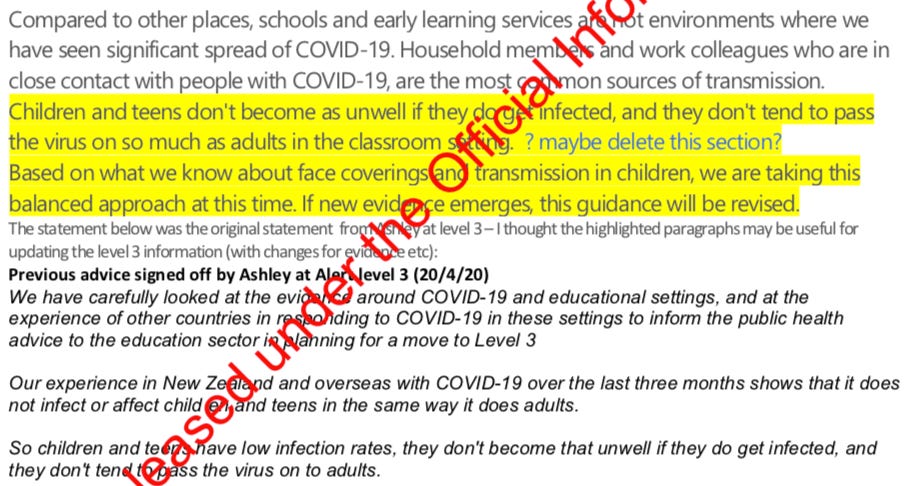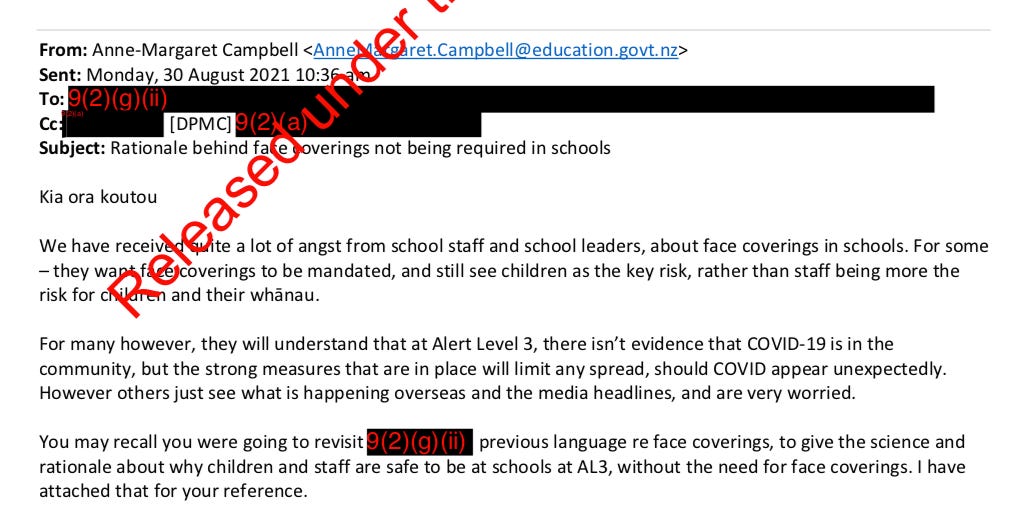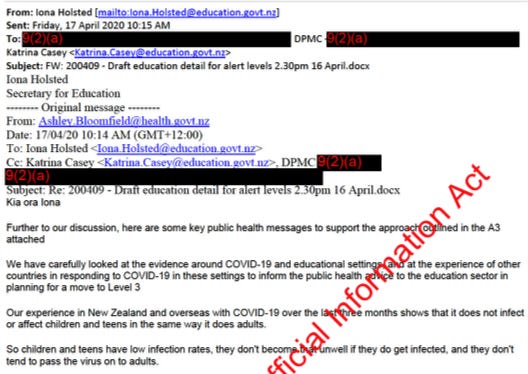AI
I write a substack based on OIAs and proactive releases called NZ Covid response – a short history. Click on my name or use this link to check it out: nzcovidresponse.substack.com
Masks in schools have been a contentious issue in several countries.
The UK WhatsApp message leak showed that masks were conceded to in order to avoid an argument, rather than for any clear and measurable benefit to children. School mask mandates in the States can be traced to teacher’s unions lobbying for mask mandates – and mandates they got.
I attempted a history of mask mandates in New Zealand because they were not just public health advice or recommendations. They were mandated in legislation with a price tag for not complying of $4,000 at the height of Covid restrictions. People were even arrested and despite what masks proponents claimed masks could clearly have harms in their use – especially as we’ll see here in schools.
When schools slowly re-opened in September 2021, following a Delta outbreak and country-wide lockdown, the Ministry of Education ordered 7 million masks to give out as mask use became openly encouraged and mandated to secondary school students and staff. Then when masks were mandated further in schools in early 2022 – they ordered a staggering 36 million more.
The total cost was just over $13.7 million.
A query in March 2023 to the Ministry of Education had them respond that “…around 31.5 million disposable ‘surgical’ face masks were still stockpiled.”
The risk of Covid to children
I think it’s important to remember that Ministry of Health advice, and across the world led by the WHO was that while there are rare exceptions, children are at low risk and just don’t get very sick if they catch Covid.
Direct advice between the Ministry of Education and the Ministry of Health confirmed this in their messaging through 2020 and 2021.
Here’s what was being said in April 2020 as the Ministry of Education leaned on the then Director-General of Health Ashley Bloomfield to create their messaging:
Bloomfield confirms to the Chief Executive of the Ministry of Education that children and teens very rarely get sick.
Preparing for back to school as Alert Levels dropped down from the country-wide lockdown in September 2021 – Ministry of Education staff weren’t sure they should even mention the low-risk Covid posted to children in their advice to schools – I wonder why?

Community mask advocacy
In New Zealand when the public transport mask mandates started in 2020 they only applied to the over 12s and school transport such as buses were exempt.
Yet all through the pandemic a group of self-called public health experts were actively lobbying for masks – including in schools as early as August of 2020. They even encouraged mask fun days for schools to normalise mask wearing to the over 5s. Some of these same experts sat on the Covid-19 Technical Advisory Group where they also advocated for masks.
Again, as the Alert Levels fell in 2021 – which meant children could go back to school, not mandating mask use in schools was beginning to get push back from school administrators:

The day of the above email of angst was the same day further community mask mandates started in essential businesses that were open and later close contact businesses and retail when physical distancing couldn’t be maintained. All of which did apply to those over 12s.
Mask use by over 12s in schools was strongly encouraged – but Covid restrictions move fast and no sooner did the Ministry tell schools that – they had to tell them at Alert Level 3 secondary school staff and students (from Year 9 and above) were now mandated to wear masks in school. Despite the above hand-wringing, media articles showed a decidedly more laid back atmosphere to masks in schools.
School mask mandates ramp up in the traffic light setting
As children slowly went back to school in September 2021, those same public health experts I mentioned were lobbying for children to wear masks – and justified children in masks in case they suffered trauma from being murderers:
That particular blog post I also detailed in the mask series as the authors wished for transparent masks so there was never any excuse to disturb your mask in case of communication difficulties! I wish I was making this up but I found this was an actual thing – transparent masks were used in a NICU in Auckland.
In December 2021, the Alert Level framework as part of Covid zero had been dropped in favour of the traffic light setting. The mask fairy granted more restrictions in early February 2022 while the red setting was in place – it came with “strengthened” mask mandates. School staff and students from Year 4 (about 8 years old now and above) were required to wear medical-grade masks indoors.
Although students were expected to provide their own mask, child sized masks were stockpiled in case they did not have one or it was damaged through the school day.
But masks did not come without difficulties and harms. A Wairarapa College English teacher sent a request to the Ministry of Education to ask for at-home learning days to try and manage mask issues:
I guess she wasn’t appreciative enough of her students not killing her?
Mandatory school mask use dropped
In April 2022, when the country moved down from red to orange within the traffic light setting, some Covid restrictions were loosened, and mandatory masking in schools was dropped.
Public health experts publicly condemned the move to drop mandatory school masking. Strong words – especially when the government appears to have dropped it as it simply wasn’t feasible to continue with. Then Covid-19 Minister Chris Hipkins said “…feedback from schools was that the requirement had been “challenging” – particularly getting young people wearing masks consistently.”
Yet in a May 2022 blog post pushing an action plan in schools, those same public health experts noted students would be doing it not for themselves but for others:
This presents a problem to me that I haven’t found explicitly discussed – children’s rights. Interventions that are mandatory for children to comply with, should surely be designed to support them, no? We saw how catching Covid was a very mild illness for most children and young people. When I see references like the above for children to mask for others – their rights are not mentioned nor the ethics of requiring children to take on the burden of allegedly protecting others – in this case, adults.
And yet again – not giving up – those public health experts developed an action plan with 150ish signatures which they sent to Minister Hipkins. Which of course, included stating mask use must be mandated in schools over the winter terms of 2022.
As winter arrived the Ministry of Education told schools they “strongly encourage mask” use by both staff and children in Years 4 and above in indoor settings to combat all winter illnesses now. To support schools the Ministry provided mask policy templates for enforcement. Media articles amplified some teachers’ fears of unmasked children – including a teacher who claimed to have resigned when the government dropped mandatory school masking.
Okay, credit where it is due, a ray of common sense was in the response to the lobbying from Minister Hipkins who described the issues with masking in schools and how it hindered education. He could also have mentioned research that alleged most children had caught Covid by that point.
And I’ll also give him credit for this interview I came across – noting mandating masks in classrooms was only one area that social interactions take place out of many interactions in a day so they didn’t always make sense when weighed against their issues in teaching. He went on to say “…there are a lot of anxieties around Covid, and children pick up on the conversations parents have, which often aren’t helpful.” As David Seymour alluded to saying in the same article – probably shouldn’t have ratcheted up the fear in the first place perhaps?
I have my suspicions here – but remember the Covid-19 Technical Advisory Group that has one of those experts sitting on it? In a July 2022 meeting a member of the group queried if not mandating masks in schools was a “missed opportunity”. They were reminded masks were “…not without consequences within education, for example, engagement from students is reduced, students with hearing disabilities and students for whom English is a second language are particularly impacted due to the lack of visual clues, and specific subjects like drama and dance are particularly impacted by mask use.”
The meeting also talked about the contradictory nature of mandating them during class time indoors but not during lunch indoors, the difficulty in ensuring they are worn correctly by children and the environmental cost of masks and finally, I like to think with an air of diplomatic frustration:

The Ministry of Education in answer to why they were only encouraging and not mandating masks, notes schools can make their own decisions on masks and that communicating effectively was important.
Was masking reducing the spread of infections in schools?
So let’s look at the evidence that was carefully being collected showing that masks reduced spread in New Zealand schools when they were mandated or strongly encouraged to be worn.
The room is bathed in silence.
In response to that question, the Ministry of Education stated “Any assessment as to the efficacy of masks in slowing the spread of COVID-19 would have been completed by the Ministry of Health.”
Okay, was the Ministry of Health doing an assessment? I asked. No. No one tracked whether mask mandates worked to reduce infections. Masks were dropped in schools because they were simply unrealistic.
I did see a weak and inconclusive attempt at quantifying it in an appendix from an August 2022 briefing on the public health value of mask mandates from the Ministry of Health to Minister Verrall:

They were attempting to review reported case rates against mask mandates in school children and teachers – but this is not just observational and self-reported – it includes a bias as teachers were given special Covid-19 leave.
Towards the end of 2022, there had been 2.2 million total reported case infections and even encouraging masks in schools had slipped away as realistic as it was hoped the removal of masking would improve poor school attendance.
Children in New Zealand were fortunately not subject to policies that were seen in other countries – sitting outside in winter, forced to wear masks outside, eating lunch silently or the indignity of being sniffed for Covid by a dog. But with another round of winter ‘waves of illness’ being announced – will calls for mask use ever crop up again?
Oh hey, those 31.5 million masks the Ministry of Education still has? The adult masks expire in February 2025 and child-size masks expire in July 2025. The Ministry said they have no plans to buy more.
Interested in the history of mask mandates in New Zealand? Start at the beginning in 2020.





